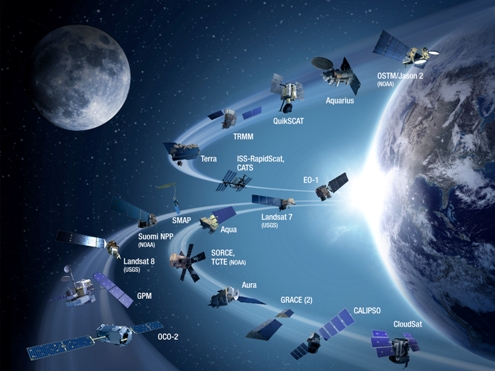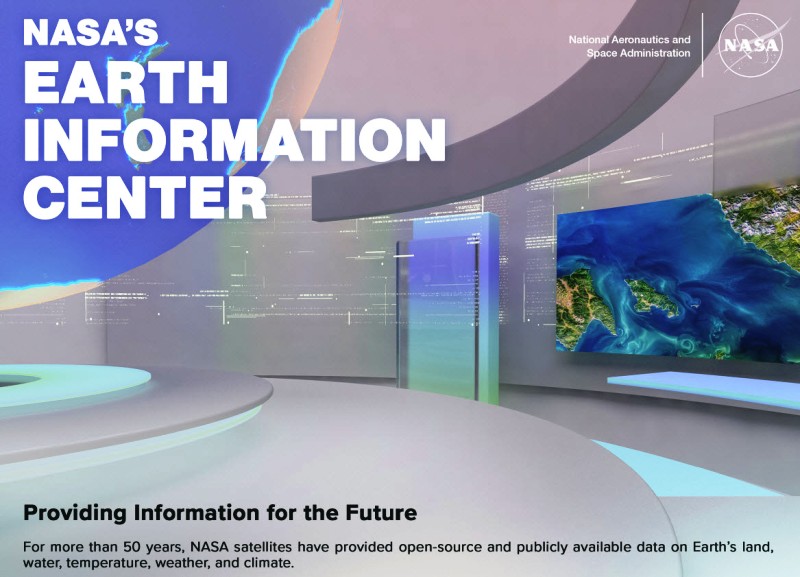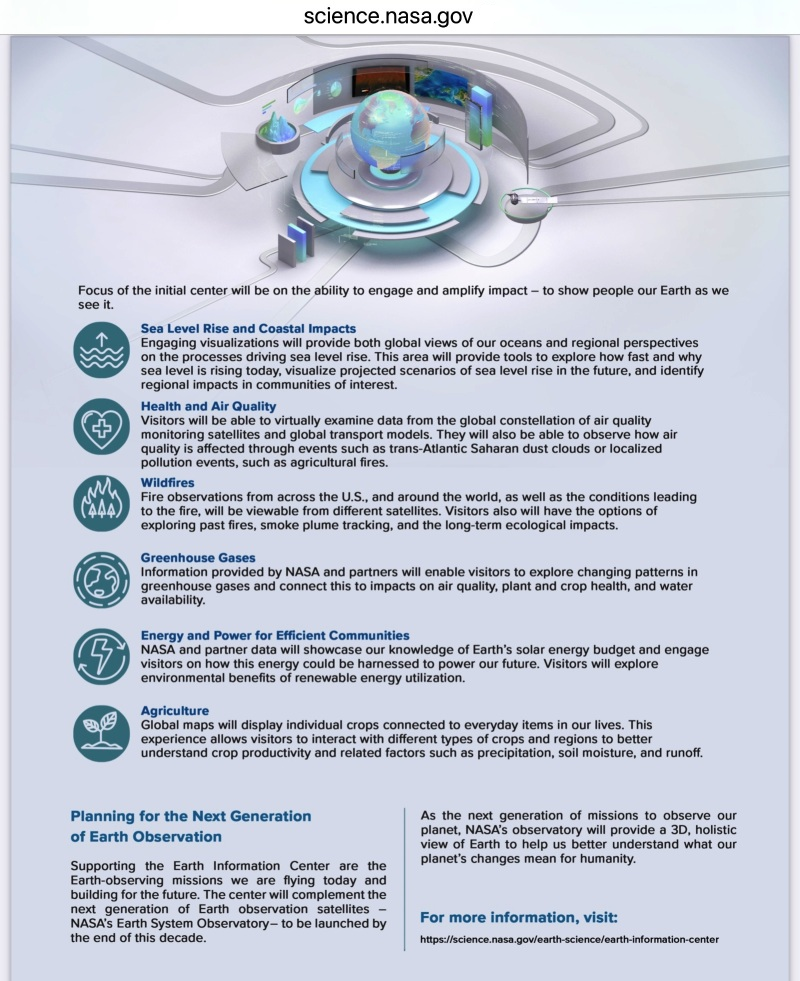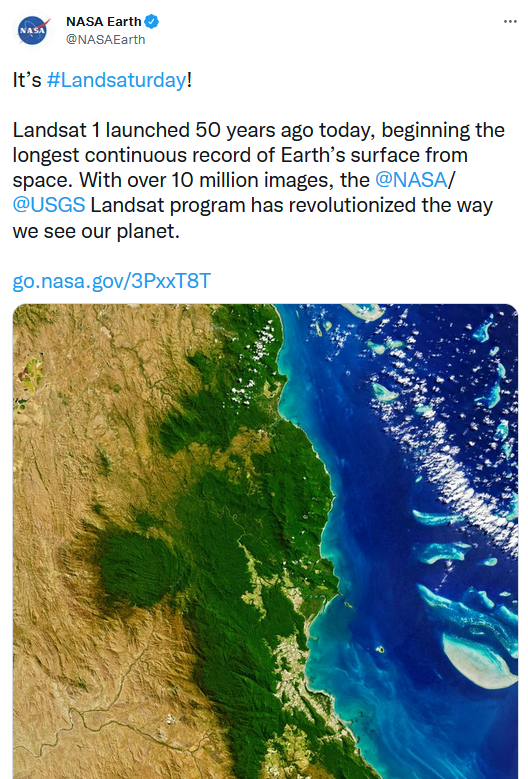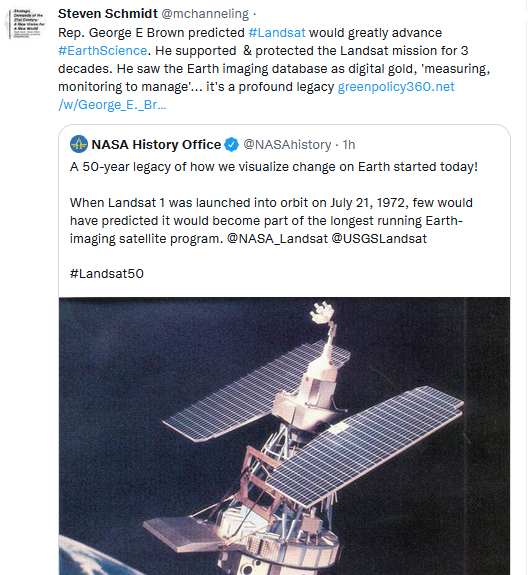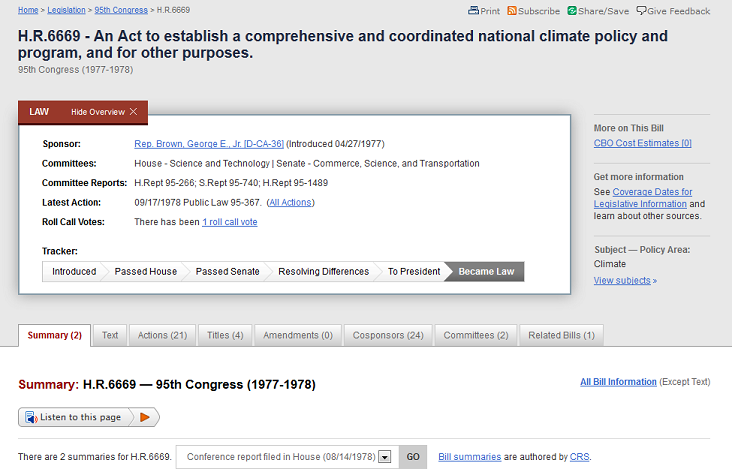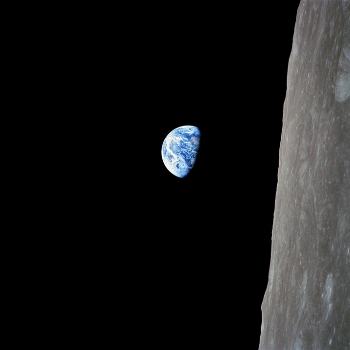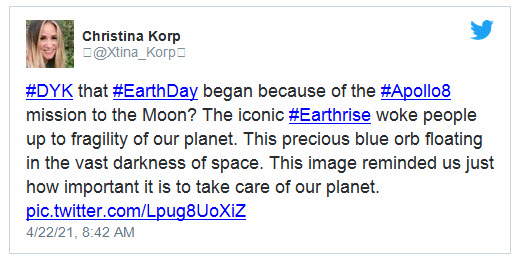File:Earth Observing System - fleet of satellites.png
Earth_Observing_System_-_fleet_of_satellites.png (740 × 576 pixels, file size: 557 KB, MIME type: image/png)
NASA Earth Science Missions continuing to extend decades of earth system science missions
EOS
Earth Observing System
Originating with a NASA 'Mission Statement' and visionary Earth Science leaders in the U.S. Congress, a whole earth research mission, environmental protection movement is launched...
GreenPolicy360 siterunner, Steven Schmidt, recalls the origins of earth science missions and visionary leaders:
The Original Mission Statement of NASA (1958) provided Congressional intent and guidance to the first generation of space programs. US Congressman George Brown, if he were here, would've done I am certain everything within his power to continue the original 'our' part of the mission statement... 'to understand and protect our home planet'...
“To understand and protect our home planet; to explore the universe and search for life; to inspire the next generation of explorers ... as only NASA can.”
The NASA programs to understand and protect can be traced to the 1960s when a monumental new technology was invented and, with a fortuitous shift in U.S. remote imaging capabilities from to digital, 'multispectral' scanning, the Landsat program took off and the data that began coming back from near-orbit Landsat satellites forever changed how we see, study and interact with our home planet.
George E. Brown Jr | LANDSAT and Virginia Tower Norwood | "Generation Green"
GreenPolicy360's archive of the 1960s/70s earth science, an environmental era start up that your GreenPolicy360 Siterunner experienced personally, includes memories that reveal rarely discussed highlights of the Landsat and first earth observation satellites, the beginnings of the Earth Observing System (EOS), a platform of digital earth system science missions now continuing in a fifth decade of vital science.
Landat's digital imaging scanner created unique digital technology enabling scientists to monitor earth's living systems and our changing environment. Zoom in on the Multispectral Scanner and "The Woman Who Brought Us the World" -- Virginia Tower Norwood. We are witnessing digital data begins to flow into databases for science around our world as NASA's original mission statement -- “To understand and protect our home planet..." becomes mission reality.
The Landsat mission was a proverbial 'game-changing moment. A mission -- "To understand and protect our home planet" -- was turned into reality. A Congressman versed in physics and trained as a engineer, and a scientist-engineer, a woman who had to convince the power-that-be, leaders of the military-industrial-complex who were unsupportive of her new digital Mulitspectral 'thing', to go forward digitally, that 'digital was the future, that databases from digital imaging were 'gold'. George Brown was an 'environmentalist' before the term became familiar, a man who was among the first to recognize the serious threat of global warming (before the term "climate change" became familiar.) Virgini Tower Norwood was a force to be reckoned with though surrounded by corporate bosses and uniformed generals. Together, George and Virginia changed our world. Landsat, not video but digital, was a profound moment, a beginning of humanity attempting to point digital imaging toward earth's living system and measure...
We, at GreenPolicy360, are remembering, up close, a first generation Earth Science visionary who was the man who can be said to be most responsible for the planning and launch of Landsat and the Landsat mission and program's oversight in the 1970s, 80s and 90s.
George E. Brown was a friend, a Congressman who worked over decades in the 21th century to create a system of Earth Science through a multi-satellite mission that continues to this day. GreenPolicy360's siterunner witnessed his work over the years and today we are extremely grateful for the unique data now, as a result, available that with open access. Planet scientists of all type, in all countries now have the facts of 'on the ground' and 'in the atmosphere' changing metrics, the measuring and monitoring of dynamics that makes managing earth systems possible. Here's a GreenPolicy360 tip of our green hat to Congressman George E. Brown who made this possible in a way that was before his time. We remember....
The Earth Observing System (EOS)
GreenPolicy360: The mission of the Earth Observing System that became a core element of the ongoing NASA earth science programs was first envisioned in the 1970s. The constellation of satellites that now comprise a connected matrix of ongoing earth digital imaging programs came about as the U.S. Congress realized in the years following NASA's establishment that Planet Earth was central to NASA's work. The initial NASA mission statement spoke of this study of Planet Earth as a key goal of NASA programs. A new science, space and technology Congressional Committee was created to envision and oversee these programs and one of the first realizations about the need for earth science came about through the LANDSAT program (see here). A historic moment brought into existence digital mapping, that is, multi-spectral imaging of earth from an orbiting satellite in space, envisioned and designed to collect and 'save' data of earth's living systems. This databank was considered to be essential by committee member George E. Brown who, as a physicist and engineer, began his three-decade + career in Congress. George eventually became known for his "big science" initiatives. What few knew back then at the beginning was how essential this data would become as climate science came into the light (in 1977 and '78 with George's work central to the drafting and passage of the first National Climate Act.)
In the 1980s, the Earth Observing System (EOS) work began in earnest.
NASA's Project Science Office years later described its beginning with this statement:
>Results from early missions shed light on critical components of the Earth system while prompting further, more advanced investigations. The NASA Earth Observing System (EOS) program was conceived in the 1980s and began to take shape in the early 1990s. EOS is comprised of a series of coordinated polar-orbiting satellites designed to monitor and understand key components of the climate system and their interactions through long-term global observations. The EOS missions focus on the following climate science areas: radiation, clouds, water vapor, and precipitation; the oceans; greenhouse gases; land-surface hydrology and ecosystem processes; glaciers, sea ice, and ice sheets; ozone and stratospheric chemistry; and natural and anthropogenic aerosols.
NASA's Earth Observing System (EOS) Reference Handbook
In June 1992, the National Space Policy Council issued National Space Policy Directive and EOS became part of a global change observation system.
Continuity of satellite missions gathering data over years established what is known as a longitudinal trendline of observations, the goal set forward in the late 1970s and 80s with LANDSAT, weather satellites and many others in the first generation of environmental science research with space-based remote imaging. This long vision would empower scientists and others to measure and monitor dynamic changes over time, a critical factor in enabling policies to be drafted to manage earth's systems. George Brown was a key factor in these decisions. He saw, as did your GreenPolicy360 siterunner who was following his work through the years, that data and sharing of data would build educational resources, science and new opportunities. Previous military intelligence programs from space, for example, were revisioned/rethought and ideas such as a Global Positioning System GPS with all of navigational potential on earth came into being under President Reagan in the 1980s. Later in the 1990s under Democratic administration the Next Generation Operational Control System acted toward increasing GPS positional accuracy. New mapping and navigation tools, now in most all new cars, were results of these programs that George Brown helped set in motion saw coming into existence before his passing away in 1999.
The Terra satellite, the first of 26 satellites that have orbited or continue to obit as a formal part of the EOS progam was launched on Dec. 18, 1999. Terra (originally known as EOS-1) was designed for a five-year mission life, but continued to orbit for more than another decade.
George was alive as the launch of the Terra EOS program happened in December 1999. He knew that his mission, his work, was continuing on as a legacy.
Again, we at GreenPolicy360 tip our hat to the vision of Planet Citizen George E. Brown, a generational thinker and doer, mover and shaker...
🌎
Visit the beginnings of Earth System Science, 1960s/70s:
- Measuring, Monitoring, Managing Earth's Dynamic/Changing Systems
- Earth Imaging, Earth Science Research from Space, Data for Today & the Future
🌎 “To understand and protect our home planet" (from the original Mission Statement of NASA)
🌎
All the Earth Science / Atmospheric and Ocean Science Missions -- https://www.nasa.gov/missions
- Measuring, Monitoring, Imaging, Researching, Data to Understand & Manage
- We are captains of our Earthship, our Living Planet, Earth is in Our Hands
In 2020, a new Observatory with a climate mission focus within the Earth Science NASA Mission
- Circa 2015
Atmospheric Science
- Earth Science to Protect & Preserve a Sustainable Earth
- Back to the Beginnings: Earth Science, New Visions of Security
- Time to act to make a positive difference
Planet Citizens, Planet Scientists, Preserving & Protecting the Home Planet Earth
GreenPolicy360 Siterunner / SJS: In the 1960s and 1970s, Representative George E. Brown proposed and set in motion a first generation of Earth Science missions and programs that continued over the decades. When one looks at today's Earth Science Research from Space and accumulative science data acquired over the decades, we are seeing the results of George's vision. As an engineer with a physics background, he knew we would need good scientific data to make the decisions guiding how we respond to the great challenges of our times, the existential threats on multiple fronts, and we are tapping into the results of programs designed to produce the knowledge base George Brown knew would be needed to make wise decisions. Whether we make the necessary decisions is up to our generation. Every generation has a 'generational responsibility' as we, at GreenPolicy360 see the challenges all of us must face, as Planet Citizens. George Brown was first to see and act as he drafted the National Climate Program Act legislation in 1978. He pushed to set up a new Science and Technology Office to press President Carter on the climate change danger (see their letter, attached here, and he continued to support and press forward with an array of scientific research programs and missions with vision over the 1980s and 1990s.
GreenPolicy360's founder was fortunate, beginning in the 1960s, to listen to Congressman Brown Congressman George E. Brown point to the NASA plan and explain how he saw Congress put into action the reality of a multi-year, coordinated, multi-agency program to achieve mission goals.
Earth science, measuring and monitoring Earth's life-enabling systems was given highest priority. Landsat's program was set in motion as a decades long, first-ever digital scanning remote satellites data collecting study. An array of satellites began to launch, creating and combining the expanding resources of NASA, USGS, NOAA, and an array of educational and scientific institutions and aeronautics business.
Fifty+ Years On
Update: July 2022
The overall goal, Representative Brown would continue to explain in his Congressional Science, Space & Technology leadership roles over the decades, was to understand, preserve and protect our planet as we, humanity, develop the science to look beyond the Earth and study 'the heavens'. The Earth Science data, imaging of the home planet, was intended to be a trove for today's research of Earth's connected life-supporting systems and a 'longitudinal study', a timeline tracking dynamic changes in Earth systems over the years...
Here's to George Brown and the many visionaries, thinkers and doers who have carried on preserving and protecting our home planet.
As George and I worked over many years we both grew in our politics as together and separately we advocated for peace and environmental protection. Big science was at the center of much of George's future-looking agenda. He believed in green politics and was a mentor to me and many.... He became a leader in Congress from California who helped shape the modern environmental movement.
California out in front in a Green future
Today many of the actions of George Brown continue as models for citizens, cities and nations of the world. California and a green political/environmental protection movement that George helped to begin continue to be out in front with ideas to improve quality of life.
In our GreenPolicy360 work, George's work continues. Even as political opposition to environmental work, anti-nuclear work, anti-war work is at risk, as we look out at a strategic horizon with pressing demands, the foundations put in place by an earlier generation remain strong.
Planet Citizens | Planet Citizens, Planet Scientists
George Brown's work remains with us in his legacy of accomplishment. I miss him often but know he is still around. I feel him when I write of green ideas and look to our kids and education and our shared future...
Let's look at some of what George accomplished before his untimely passing in 1999:
George was instrumental in proposing and establishing the Presidential Office of Science and Technology Policy in 1976. He was working alongside the National Academy of Sciences as they released a first-ever climate report in 1977. In 1977 he and the new Office of Science and Technology sent a first government warning of "climatic fluctuation" and "catastrophic" change to President Carter:
Congressman Brown Out in Front of Climate Action
At the Beginning of U.S. Science on Global Warming, Strategies & Planning
1978, the First Climate Actions
In 1979 came the first follow-on National Science Academy report. This study and report of national scientists was prescient and accurate in its global warming predictions.
First National Climate Act, Historic Work, 1978
GreenPolicy360 Siterunner / SJS: The beginnings of modern environmental and climate science can be traced to the 1960s and 1970s. The U.S. National Academy of Sciences played a key role in laying a foundation of scientific reports and data.
Energy and Climate Report, 1977, National Academy of Sciences / 175 pp. / PDF via GreenPolicy360
Rep. George Brown took the findings of the 1977 Energy and Climate Report from the Academy of Sciences and made the science actionable. In a historic moment, he proposed and drafted the legislation of the first U.S. National Climate Program and shepherded its passage in 1978.
This first federal program established to study and assess scientifically the issues and risks of human-caused climate change became a foundation for comprehensive initiatives, with an array of new Earth Science missions led by NASA and NOAA, the EPA and USGS.
🌎
In his rumpled suits and quiet way George E. Brown moved to form coalitions few thought could be formed and garnered support for the first set of U.S. Congressional acts that served as foundation legislation for decades of green progress.
The First Earth Day: Personal Memories by Steven Schmidt of George's Role
🌎
File history
Click on a date/time to view the file as it appeared at that time.
| Date/Time | Thumbnail | Dimensions | User | Comment | |
|---|---|---|---|---|---|
| current | 13:19, 10 October 2022 |  | 740 × 576 (557 KB) | Siterunner (talk | contribs) |
You cannot overwrite this file.
File usage
The following 50 pages use this file:
- About Us
- Climate Change - Global Warming Keyword-Terms
- Climate News
- Climate Plans Enforcement - Resources
- Climate Problems, Climate Solutions
- EarthPOV
- Earth Imaging-New Space
- Earth Right Now
- Earth Science Research from Space
- Earth Science Vital Signs
- Earth and Space, Politics
- Ecolivia
- Environmental Studies Online
- Environmental protection
- Generation Green
- George E. Brown Jr
- GreenPolicy360 Archive Highlights 2021
- GreenPolicy360 Archive Highlights 2023
- Green New Deal
- Green Stories of the Day
- INDCs
- PlanetCitizen
- Planet Citizen Action
- Planet Citizens
- Planet Citizens, Planet Scientists
- File:CO2 photo.JPG
- File:ClimateNews 360.jpg
- File:Digital.png
- File:Earth-NASA.jpg
- File:EarthRightNow Earth Science satellite fleet circa 2015 m.jpg
- File:EarthScience Missions via the EOS - 2022.png
- File:Earth Summit 1992.jpg
- File:Earth System Observatory.jpg
- File:Global Stocktake, the first GST.jpg
- File:Global climate conferences and GHG increases.jpg
- File:How satellites monitor climate change circa 2016.png
- File:Monitoring Greenhouse Gases from Satellite Missions 2021-2030.png
- File:Multispectral Scanning Systen - MSS.jpg
- File:NASA EPIC DSCOVR - July 6 2015.png
- File:NASA has a new mission... against Methane.png
- File:Rep George Brown and Steve Schmidt - Oct 15, 1969 - 448x305.png
- File:The Original Mission Statement of NASA.png
- File:What happens next is ... the Greenhouse Effect - explained by Carl Sagan, 1985.png
- File:You can manage only what you can measure Dr David Crisp, OCO-2, June 2014 m.jpg
- Category:About Us
- Category:Climate Policy
- Category:Earth System Science
- Category:Ecology Studies
- Category:Environmental Security
- Category:NASA
- About Us
- Arctic
- Atmosphere
- Biodiversity
- Climate Change
- Climate Policy
- Digital Citizen
- Earth360
- Earth Imaging
- Earth Law
- Earth Observations
- Earth Science
- Earth Science from Space
- Earth System Science
- Eco-nomics
- Eco-Spirituality
- Ecology Studies
- Ecoregions
- Education
- Environmental Full-cost Accounting
- Environmental Security
- Environmental Security, National Security
- EOS eco Operating System
- ESA
- Externalities
- Fisheries
- Forests
- Food-Related Policies
- Global Security
- Global Warming
- Green Graphics
- ISS
- Land Ethic
- Maps
- NASA
- Natural Resources
- New Definitions of National Security
- New Space
- NOAA
- Oceans
- Ocean Ecosystem
- Ocean Science
- Ocean Sustainability
- Planet Citizen
- Planet Citizens
- Planet Scientist
- Planet Citizens, Planet Scientists
- Sea-Level Rise & Mitigation
- Soil
- Solar Energy
- Strategic Demands
- Sustainability
- Sustainability Policies
- ThinBlueLayer
- Threat Multiplier
- US Environmental Protection Agency
- Whole Earth
- World Wide Web
- Atmospheric Science
- Biogeosciences
- Cryosphere
- Geophysics and Geochemistry
- Mineralogy
- Geology
- Geophysics
- Hydrology
- Planetary Science
- Space Science and Space Physics




